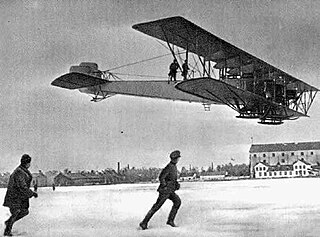
The Sikorsky Ilya Muromets was a class of Russian pre-World War I large four-engine commercial airliners and military heavy bombers used during World War I by the Russian Empire. The aircraft series was named after Ilya Muromets, a hero from Slavic mythology. The series was based on the Russky Vityaz or Le Grand, the world's first four-engined aircraft, designed by Igor Sikorsky. The Ilya Muromets aircraft as it appeared in 1913 was a revolutionary design, intended for commercial service with its spacious fuselage incorporating a passenger saloon and washroom on board. The Ilya Muromets was the world's first multi-engine aircraft in production and at least sixty were built. During World War I, it became the first four-engine bomber to equip a dedicated strategic bombing unit. This heavy bomber was unrivaled in the early stages of the war, as the Central Powers had no aircraft capable enough to rival it until much later.
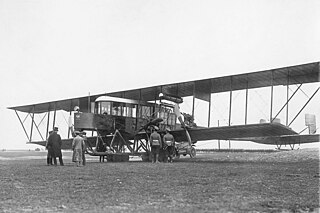
The Sikorsky Russky Vityaz, or Russian Knight (S-21), previously known as the Bolshoi Baltisky(The Great Baltic) in its first four-engined version, was the first four-engine aircraft in the world, designed by Igor Sikorsky and built at the Russian Baltic Railroad Car Works in Saint Petersburg in early 1913.
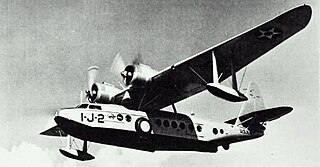
The Sikorsky S-43 is a 1930s American twin-engine amphibious flying boat monoplane produced by Sikorsky Aircraft.

The PZL-Mielec M-20 Mewa is a licence-built version of the Piper PA-34 Seneca II manufactured in Poland by WSK PZL Mielec in a limited series from the 1980s.

The Sikorsky S-16, or RBVZ S-XVI, was a Russian equi-span single-bay two-seat biplane designed by Igor Sikorsky in 1914-15. Conceived in response to demand for an escort fighter for the Ilya Muromets bombers, it was noteworthy in that it was one of the first aircraft to possess synchronisation gear for its 7.7 mm machine gun. The first S-XVI was completed on 6 February 1915 with an 80 hp engine instead of the intended 100 hp because of supply problems. On 17 December 1915, the Russian government placed an order for 18 aircraft, these being delivered in early 1916.

The Sikorsky S-20 or RBVZ S-XX was a Russian single-bay unequal span two-seat biplane designed by Igor Sikorsky in 1916. Displaying some Nieuport influence, it saw very little service during World War I.

The Sikorsky S-10 was a Russian military twin-float seaplane that served with the Russian Navy's Baltic Fleet from the summer of 1913 to 1915. After Igor Sikorsky built the successful Sikorsky S-6 for the Russian military, he tried to build another successful aircraft for them. The S-10 was a modified S-6B built by the Russo-Baltic Carriage Factory. Approximately sixteen production versions of the S-10 were built. It had a less powerful engine and generally weaker structure than the S-6. They had either an 80 hp Gnome Monosoupape or a 100 hp Argus Motoren engine. Some were deployed on the world's first operational seaplane carriers.
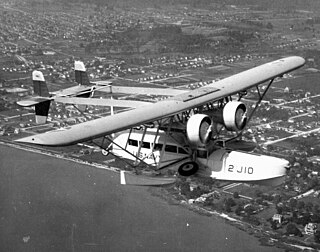
The Sikorsky S-41 was an amphibious flying boat airliner produced in the United States in the early 1930s. Essentially a scaled-up monoplane version of the Sikorsky S-38 biplane flying boat, Pan Am operated the type on routes in the Caribbean, South America, and between Boston and Halifax.

The Wright Model D was built to sell to the United States Army for an observation aircraft. It was similar in design to the Wright Model R with a 6-60 motor. The Model D could fly 66.9 mph and climb 525 feet per minute, but its excessive landing speed discouraged the Army from ordering more.

The Joplin Tundra is a family of Canadian, high-wing, strut-braced, pusher configuration ultralight aircraft that was originally produced by Back Forty Developments of Campbellford, Ontario, Canada and later by Joplin Light Aircraft of Joplin, Missouri and Laron Aviation of Borger, Texas for amateur construction. The aircraft is out of production.

The Sikorsky S-5 was an early Russian single seat biplane design by Igor Sikorsky, completed in late April 1911.

The Fly Synthesis Syncro is an Italian ultralight and light-sport aircraft, designed and produced by Fly Synthesis, introduced at the Aero show held in Friedrichshafen in 2009. The aircraft is supplied as a complete ready-to-fly-aircraft.
The Harris Geodetic LW 108 is an American homebuilt aircraft that was designed by J. Warren Harris of Vernal, Utah and made available in the form of plans for amateur construction.
The Star-Lite Warp 1-A is an American homebuilt aircraft that was designed and produced by Star-Lite Engineering of Englewood, Ohio, introduced in 1996. When it was available the aircraft was supplied as a kit for amateur construction.

The Sikorsky S-8Malyutka (baby) was a small Russian single engine aircraft built by the Russian Baltic Railroad Car Works shortly after Igor Sikorsky became chief engineer of the aircraft manufacturing division in 1912.
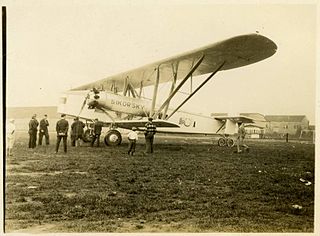
The Sikorsky S-37 was an American twin-engine aircraft built by the Sikorsky Manufacturing Corporation. Both examples of the series were completed in 1927. The S-37 was specifically designed to compete for the Orteig Prize and would be the last land based fixed-wing aircraft Sikorsky would produce.

The Sikorsky S-7 was a Russian single engine experimental prototype aircraft built by the Russian Baltic Railroad Car Works shortly after Igor Sikorsky became chief engineer of the aircraft manufacturing division.

The Sikorsky S-33 Messenger was an American two-seat sesqiuplane designed and built by the Sikorsky Manufacturing Corporation in 1925.

The Sikorsky S-9Kruglyj was a Russian single engine prototype aircraft completed in the spring of 1913 by the Russian Baltic Railroad Car Works while Igor Sikorsky was the chief engineer of the aircraft manufacturing division.

The Sikorsky S-11 Polukroogly was a Russian single engine prototype reconnaissance aircraft completed in July 1913 by the Russian Baltic Railroad Car Works while Igor Sikorsky was the chief engineer of the aircraft manufacturing division.



















